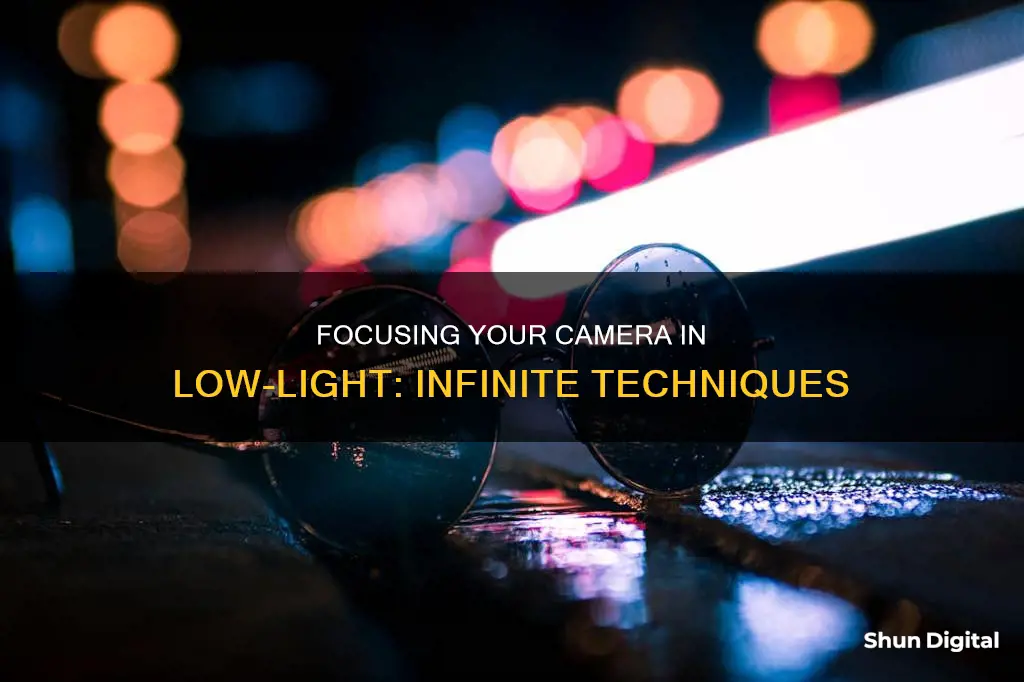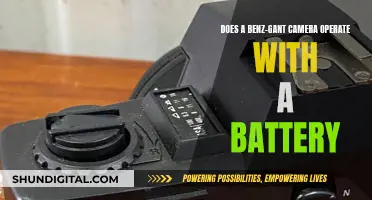
Focusing a camera in the dark can be challenging, as camera focus systems rely on the contrast between bright and dark areas of the photo to achieve focus. This is where infinity focus comes in. Infinity focus is a setting where everything beyond your lens’ hyperfocal distance will be in focus. In other words, infinity focus is the opposite of a narrow depth of field. It is ideal for nighttime photography, allowing you to achieve peak sharpness without relying on your camera’s autofocusing abilities.
| Characteristics | Values |
|---|---|
| Definition of infinity focus | A setting where everything beyond the lens' hyperfocal distance will be in focus |
| Use case | Nighttime photography |
| Manual focus method | Turn the lens into manual focus mode and turn the focus ring until the straight line marker lines up with the infinity symbol |
| Auto-focus method | Auto-focus on a distant object during the day, then turn off auto-focus and lock the focus ring until the night shoot |
| Hyperfocal distance | The closest distance at which a lens can be focused while keeping objects at infinity 'acceptably sharp' |
| Challenges | Cameras have a much more difficult time 'seeing' in the dark; auto-focus function may become very difficult or impossible to use |
What You'll Learn

Infinity focus vs. hyperfocal distance
Infinity focus and hyperfocal distance are two different techniques used in photography to achieve a sharp image. Infinity focus is when the lens is focused on a distant object, such as a bright star or a mountain range, resulting in a sharp image of that object. Hyperfocal distance, on the other hand, is the focusing technique that gives the greatest depth of field, ensuring that both the foreground and background of an image are sharp.
Infinity Focus
Infinity focus is often used in astrophotography to capture sharp images of stars or other distant objects. To achieve infinity focus, photographers manually adjust their lens to focus on the most distant object in the scene. This can be done by using the "live view" feature on their camera and zooming in on the distant object to aid in focusing. Once the lens is focused on infinity, photographers know that any photograph they take of the sky will feature stars that are in focus, regardless of the camera's position.
Hyperfocal Distance
Hyperfocal distance is the focusing technique that gives the greatest depth of field, making both the foreground and background appear sharp. This technique is particularly useful in landscape photography when photographers want to capture sharp images of objects in the foreground and background. The hyperfocal distance can vary depending on the aperture and focal length used. Wider apertures, such as f/2, require focusing further away from the camera to achieve a sharp image. In contrast, smaller apertures, such as f/11 or f/16, result in sharper images even when the lens is focused more closely.
Additionally, the focal length also impacts hyperfocal distance. A shorter focal length, such as a 20mm lens, requires focusing closer to the camera, while a longer focal length, such as a 200mm lens, requires focusing farther away.
There are several methods to determine the hyperfocal distance, including using hyperfocal distance charts, focusing scales on lenses, or smartphone apps. One simple method is the "Double the Distance" technique, where photographers estimate the distance to the closest object in the scene and then focus the lens at twice that distance. This ensures that both the foreground and background are sharp.
The main difference between infinity focus and hyperfocal distance lies in their purpose and application. Infinity focus is used when the goal is to capture a sharp image of a distant object, such as stars or mountains. Hyperfocal distance, on the other hand, is used when photographers want to maximise the depth of field and keep both the foreground and background in focus. Infinity focus is often used in astrophotography, while hyperfocal distance is commonly employed in landscape photography.
While infinity focus ensures the sharpness of distant objects, hyperfocal distance provides a greater depth of field, allowing for both near and far objects to be captured sharply. Additionally, hyperfocal distance can be adjusted based on aperture and focal length settings, providing photographers with more control over their images.
In summary, both infinity focus and hyperfocal distance are valuable techniques in a photographer's toolkit. Infinity focus is ideal for capturing the sharpness of distant objects, while hyperfocal distance excels at maximising the depth of field and keeping both foreground and background elements in focus.
Speco Cameras: Where Are They Manufactured?
You may want to see also

Infinity focus with an autofocus lens
Infinity focus is a setting where everything beyond your lens' hyperfocal distance is in focus. This is ideal for nighttime photography as it allows you to focus on things beyond what your camera would usually be able to focus on, without an autofocus system.
To achieve infinity focus with an autofocus lens, you will need to switch to manual focus mode. Then, turn the focus ring until the straight line marker lines up with the infinity symbol, which is located at the end of the focus ring. Note that the infinity mark is not always at the very end of the focus ring and many lenses will turn past this mark, so be sure to line up the marker perfectly with the infinity symbol.
If you are using a zoom lens, set your preferred focal length before focusing. If you are using a lens with a variable focal length, you will need to set the focal length before focusing, as the focus may change as you zoom in and out.
It is also worth noting that infinity focus points can be altered in high temperatures, so if you are not obtaining sharpness, try moving the focus point slightly past the infinity mark.
Using a tripod when photographing a dark scene will help with sharpness and ensure your camera is stable. Infinity focus is a useful tool for photographing long exposures, fireworks, and night scenes.
Loading Batteries into Your DXG 552 Camera: A Step-by-Step Guide
You may want to see also

Focusing on a distant light source
- If the moon is out, auto-focus on it, then switch the camera or lens to manual focus.
- If there is no moon, look for a distant house or yard light on the horizon and auto-focus on that.
- If the light is bright enough and large enough, your camera should have no problem locking onto it.
- After auto-focusing, switch the camera or lens to manual focus to prevent the camera from hunting for focus when you press the shutter button.
- Consider using gaffer's tape to prevent the focus ring from moving.
- If all attempts at using autofocus fail, or if you want to fine-tune the focus, turn off autofocus and use the manual focus ring on the lens barrel.
- Use Live View and zoom in on the focus point on the LCD screen. When focusing on a point light source, zoom in as far as possible, and slowly turn the focus ring. The lens is focused when the point of light is at its smallest on the screen.
Newburgh Heights Camera Tickets: Are They Worth Paying?
You may want to see also

Using a flashlight to focus
First, it is important to understand the limitations of autofocus in low-light settings. Even with advancements in autofocus technology, cameras still struggle to focus in the dark due to the lack of light and contrast. Therefore, it is helpful to introduce additional light to assist the autofocus.
A cheap LED flashlight can be a useful tool to help your camera focus in dark environments. Place your camera on a tripod to keep it stable, and then use the flashlight to illuminate your subject. Point the flashlight at the subject, focus your camera, and then turn off the flashlight before capturing the shot. This technique provides the necessary light and contrast for your camera to focus accurately.
Another trick with a flashlight is to place it within the scene at the desired focus distance. Focus your camera on the flashlight, lock the focus, and then remove the flashlight before taking the photo. This ensures that the objects at that distance will be in focus.
When using a flashlight to focus, it is important to remember to turn off the flashlight before capturing the final shot. Leaving the flashlight on can create an unwanted specular highlight on shiny objects or eyes, even if it does not affect the exposure.
Additionally, consider using a wide-aperture lens. A bright lens with a wide aperture allows more light to reach your camera's autofocus system, resulting in faster and more accurate focusing. However, keep in mind that a razor-thin depth of field may be more challenging to work with, as any movement of the subject can result in a loss of focus.
In some cases, you may also need to adjust your focus manually. Start by ensuring that your subject and camera remain static. Measure the distance between them and set your focus accordingly. It is recommended to use gaffer tape to mark the position of your subject and to secure the focus ring on the lens to prevent accidental adjustments. Additionally, stopping down your lens increases the depth of field, providing more margin for error and allowing for slight movements of the subject without losing focus.
By combining these techniques, you can effectively use a flashlight to assist your camera's autofocus and achieve sharp photos in low-light conditions.
Replacing JVC Camera Batteries: A Step-by-Step Guide
You may want to see also

Manual focus
Infinity focus is a setting where everything beyond your lens's hyperfocal distance is in focus. This is ideal for night-time photography as it allows you to focus on objects beyond what your camera would usually be able to focus on without an autofocus system.
To use infinity focus, you will need to switch your lens to manual focus mode. You can do this by locating the focusing mode switch on your camera or lens, which will likely be labelled "AF/MF", and switching it to "MF". Once you have done this, find the focus ring, which is usually near the middle of the lens barrel for a prime lens or near the end for a zoom lens. Then, twist the focus ring until the straight line marker lines up with the infinity symbol at the end of the focus ring. This symbol will look different depending on the brand of lens you are using, but the infinity marker is always the same design.
It is important to note that the infinity mark may not be exactly at the end of the focus ring and some lenses will turn past this mark or indefinitely, so be sure to line up the marker perfectly with the infinity symbol. This will ensure an ideal sharpness for your scene.
Some cameras, like the Olympus OM-D E-M1X and E-M1 Mark II, also allow you to preset your manual focusing distance and offer it as a focus option in their menu. If you are using an Olympus camera, your camera might be set to reset the focus if you switch between auto and manual focus. To turn this function off, go to the gear menu, A4, Reset Lens, and set it to Off.
If you are not obtaining sharpness with infinity, try moving it a bit past the mark, as infinity focus points can be altered in high temperatures. Some camera lenses, like those from Canon, feature an infinity compensation mark, which gives you a short range of distances to choose from.
When photographing in the dark, it is always best to use a tripod to help with sharpness and stability. Infinity focus is a useful tool for photographing things like long exposures, fireworks, and night scenes.
Bayit Outdoor Camera: Is It Battery-Powered?
You may want to see also
Frequently asked questions
Infinity focus is a setting where everything beyond your lens' hyperfocal distance is in focus. In other words, it's when your lens is focused on objects at an infinite distance, making them appear sharp.
Not all lenses support infinity focus. Standard lenses often do, while specialty lenses like fisheye and macro usually don't. Check your lens specifications or manual to confirm.
First, switch your lens to manual focus mode. Then, turn the focus ring until the straight line marker lines up with the infinity symbol (∞) on the focus ring. This symbol is usually at the end of the focus ring and looks the same across different lens brands.
Here are a few tips:
- Use a tripod to stabilise your camera and avoid blurry images due to camera shake.
- Avoid in-camera noise reduction, as it can soften your images.
- If using an autofocus lens, focus on a distant light source, like the moon or a bright planet, then switch to manual focus to lock in the infinity setting.
- If there are no distant light sources, use a flashlight or headlamp to illuminate an object and focus on that.







